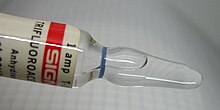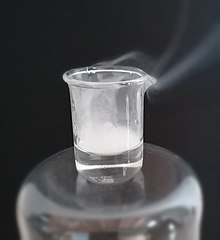Trifluoroacetic acid
| |||

| |||

| |||
| Names | |||
|---|---|---|---|
| Preferred IUPAC name
Trifluoroacetic acid | |||
| Other names
2,2,2-Trifluoroacetic acid
2,2,2-Trifluoroethanoic acid Perfluoroacetic acid Trifluoroethanoic acid TFA | |||
| Identifiers | |||
3D model (
JSmol ) |
|||
| 742035 | |||
| ChEBI | |||
| ChEMBL | |||
| ChemSpider | |||
ECHA InfoCard
|
100.000.846 | ||
| 2729 | |||
PubChem CID
|
|||
RTECS number
|
| ||
| UNII | |||
CompTox Dashboard (EPA)
|
|||
| |||
| |||
| Properties | |||
| C2HF3O2 | |||
| Molar mass | 114.023 g·mol−1 | ||
| Appearance | colorless liquid | ||
| Odor | Pungent/Vinegar | ||
| Density | 1.489 g/cm3, 20 °C | ||
| Melting point | −15.4 °C (4.3 °F; 257.8 K) | ||
| Boiling point | 72.4 °C (162.3 °F; 345.5 K) | ||
| miscible | |||
| Vapor pressure | 0.0117 bar (1.17 kPa) at 20 °C[1] | ||
| Acidity (pKa) | 0.52 [2] | ||
Conjugate base
|
trifluoroacetate
| ||
| -43.3·10−6 cm3/mol | |||
| Hazards | |||
| Occupational safety and health (OHS/OSH): | |||
Main hazards
|
Highly corrosive | ||
| GHS labelling: | |||
 
| |||
| Danger | |||
| H314, H332, H412 | |||
| P260, P261, P264, P271, P273, P280, P301+P330+P331, P303+P361+P353, P304+P312, P304+P340, P305+P351+P338, P310, P312, P321, P363, P405, P501 | |||
| NFPA 704 (fire diamond) | |||
| Safety data sheet (SDS) | External MSDS | ||
| Related compounds | |||
Related perfluorinated acids
|
|||
Related compounds
|
Acetic acid Trichloroacetic acid | ||
Except where otherwise noted, data are given for materials in their standard state (at 25 °C [77 °F], 100 kPa).
| |||
Trifluoroacetic acid (TFA) is an
Synthesis
TFA is prepared industrially by the
- CH
3COCl + 4 HF → CF
3COF + 3 H
2 + HCl - CF
3COF + H
2O → CF
3COOH + HF
Where desired, this compound may be dried by addition of trifluoroacetic anhydride.[5]
An older route to TFA proceeds via the oxidation of 1,1,1-trifluoro-2,3,3-trichloropropene with potassium permanganate. The trifluorotrichloropropene can be prepared by Swarts fluorination of hexachloropropene.[6]
Uses

TFA is the precursor to many other fluorinated compounds such as
TFA is popularly used as a strong acid to remove
At a low concentration, TFA is used as an ion pairing agent in
TFA is used to produce trifluoroacetate salts.[11]
Safety
Trifluoroacetic acid is a corrosive strong acid
TFA's reaction with bases and metals, especially light metals, is strongly exothermic. The reaction with lithium aluminium hydride (LAH) results in an explosion.[13]
TFA is a metabolic breakdown product of the volatile anaesthetic agent halothane. It is thought to be responsible for halothane induced hepatitis.[14]
Environment
No known natural processes generate trifluoroacetic acid.
Trifluoroacetic acid degrades very slowly in the environment. Median concentrations of a few micrograms per liter have been found in beer and tea.[16] Sea water contains about 200 ng of TFA per liter.[17][18][19] No biodegradation mechanism for the compound is known in water,[20] although biotransformation apparently decarboxylates the acid to fluoroform.[21]
Trifluoroacetic acid is mildly
See also
- Fluoroacetic acid – highly toxic but naturally occurring rodenticide CH2FCOOH
- Difluoroacetic acid
- Trichloroacetic acid, the chlorinated analog
References
- ^ Kreglewski, A. (1962). "Trifluoroacetic acid". Welcome to the NIST WebBook. 10 (11–12): 629–633. Retrieved 1 March 2020.
- ISBN 978-1-4987-5429-3.
- ^ Note: Calculated from the ratio of the Ka values for TFA (pKa = 0.23) and acetic acid (pKa = 4.76)
- ^ ISBN 978-3527306732.
- ISBN 978-1-85617-567-8.
- ^ Gergel, Max G. (March 1977). Excuse me sir, would you like to buy a kilo of isopropyl bromide? (PDF). Pierce Chemical. pp. 88–90.
- ISBN 978-0-471-93623-7.
- PMID 744685.
- ISBN 978-3-527-63182-7.
- .
- S2CID 250765145.
- .
- ^ Safety data sheet for Trifluoroacetic acid (PDF) from EMD Millipore, revision date 10/27/2014.
- PMID 31643481, retrieved 15 July 2021
- S2CID 239768006.
- S2CID 232115008.
- PMID 11811478.
- PMID 16190212.
- PMID 11811478.
- ^ "Refreshingly cool, potentially toxic". Ludwig-Maximilians-Universität (LMU) Munich. 2014. Retrieved 26 July 2018.
- ^ Kirschner, E., Chemical and Engineering News 1994, 8.
- .



